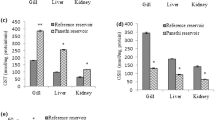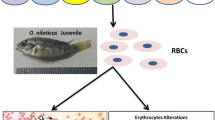Abstract
Nowadays, pollution of aquatic ecosystems with heavy metals is one of the most important environmental challenges due to toxicity, stability, and bioaccumulation in the environment. Heavy metals accumulate in aquatics and plant tissues and can eventually threaten human health by transmission into the food chain. For this reason, in the present study, the effect of copper sulfate (CuSO4) and its transmission in the food chain of Artemia franciscana, Danio rerio (Zebra), and Astronotus ocellatus (Oscar) were investigated. Initially, lethal concentration of Cu on Artemia was obtained in 24 h. In the first step, Zebra fishes fed with Artemia (under copper sulfate exposure (LC50)) and water (clean and 10% of CuSO4) treatments. In the second step, Oscar fishes fed with Zebra (under copper sulfate exposure (LC50)) and water (clean and 10% of CuSO4) treatments. In the last step, the concentration of Cu was measured in liver tissues of Zebra and Oscar fishes. Also, the variation of glucose and enzymes including Alanine aminotransferase (ALT), Aspartate aminotransferase (AST), and Autologous Conditioned Plasma (ACP) was measured. The results of this study showed that Cu causes histopathological changes liver tissues including hyperemia, necrosis, hepatic portal vein, hepatocyte destruction, nucleolysis, bile stasis, and biliary edema. Also, a strong positive and significant correlation was observed between Cu and increasing glucose and ALT, AST, and ACP.



Similar content being viewed by others
Data Availability
Data will be made available upon request.
Change history
21 July 2021
The original version of this paper was updated. The word Cooper in the article title should be changed to Copper.
References
Abou El-Naga EH, El-Moselhy KM, Hamed MA et al (2005) Toxicity of cadmium and copper and their effect on some biochemical parameters of marine fish mugil sheheli. Egypt J Aquat Res 3(2):60–71
Amat F et al (2005) The American brine shrimp as an exotic invasive species in the western Mediterranean. Biological Invasions 7:37–47. https://doi.org/10.1007/1-4020-3870-4_5
Baker RTM, Handy RD, Davies SJ, Snook JC (1998) Chronic dietary exposure to copper affects growth, tissue lipid peroxidation, and metal composition of the grey mullet, Chelon labrosus. Mar Environ Res 45:357–365
Banaee M, Mohammadipour S, Madhani S (2015) Effects of sublethal concentrations of permethrin on bioaccumulation of cadmium in zebra cichlid (Cichlasoma nigrofasciatum). Toxicol Environ Chem 97(2):200–207. https://doi.org/10.1080/02772248.2015.1031668
Bojun Y, Xueli W, Kylie F, Gexin X, Dong Ma (2020) Heavy metal concentrations in aquatic organisms (fishes, shrimp and crabs) and health risk assessment in China. Mar Pollut Bull 159:111505. https://doi.org/10.1016/j.marpolbul.2020.111505
Boudou A, Ribeyre F (1989) Fish as ‘“biological model”’for experimental studies in ecotoxicology. Aquat Ecotoxicol Fundam Concepts Methodol 8:127–150
Dos Santos Carvalho C, Fernandes MN (2008) Effect of copper on liver key enzymes of anaerobic glucose metabolism from freshwater tropical fish Prochilodus lineatus. Comp Biochem Physiol A Mol Integr Physiol 151:437–442
Eisler R (1998) Copper hazards to fish, wildlife, and invertebrates: a synoptic review. US Department of the Interior, US Geological Survey Biological Science Report, 310 p.
Gajbhiye SN, Hirota R (1990) Toxicity of heavy metals to brine shrimp Artemia. J Indian Fish Assoc 20:43–50
Gioda CR, Loro VL, Pretto A, Salbego J, Dressler V, Flores EMM (2013) Sublethal zinc and copper exposure affect acetylcholinesterase activity and accumulation in different tissues of Leporinus obtusidens. Bull Environ Contam Toxicol 90:12–16
Guan Q, Wang L, Pan B, Guan W, Sun X, Cai A (2016) Distribution features and controls of heavy metals in surface sediments from the riverbed of the Ningxia-Inner Mongolian reaches, Yellow River, China. Chemosphere 144:29–42. https://doi.org/10.1016/j.chemosphere.2015.08.036
Hadjispyrou S, Kungolos A, Anagnostopoulos A (2001) Toxicity, bioaccumulation, and interactive effects of organotin, cadmium, and chromium on Artemia franciscana. Ecotoxicol Environ Saf 49:179–186
Havens KE (1994) An experimental comparison of the effects of two chemical stressors on a freshwater zooplankton assemblage. Environ Pollut 84:245–251
Kaur G, Kumar R, Mittal S, Sahoo PK, Vaid U (2021) Ground/drinking water contaminants and cancer incidence: a case study of rural areas of South West Punjab, India. Hum Ecol Risk Assess 27:205–226
Laurén DJ, McDonald DG (1987) Acclimation to copper by rainbow trout, Salmo gairdneri: biochemistry. Can J Fish Aquat Sci 44:105–111
Li J, Quabius ES, Bonga SEW, Flik G, Lock RAC (1998) Effects of water-borne copper on branchial chloride cells and Na+/K+-ATPase activities in Mozambique tilapia (Oreochromis mossambicus). Aquat Toxicol 43:1–11
Malik N, Biswas AK, Qureshi TA, Borana K, Virha R (2010) Bioaccumulation of heavy metals in fish tissues of a freshwater lake of Bhopal. Environ Monit Assess 160:267–276
Nyambura C, Hashim NO, Chege MW, Tokonami S, Omonya FW (2020) Cancer and non-cancer health risks from carcinogenic heavy metal exposures in underground water from Kilimambogo Kenya. Groundw Sustain Dev 10:100315
Ogamba EN, Charles EE, Izah SC (2021) Distributions, pollution evaluation and health risk of selected heavy metal in surface water of Taylor creek, Bayelsa State, Nigeria. Toxicol. Environ. Health Sci. 1–13.
Oliva-Teles A (2000) Recent advances in European sea bass and gilthead sea bream nutrition. Aquac Int 8:477–492
Pelgrom S, Lock RAC, Balm PHM, Bonga SEW (1995) Integrated physiological response of tilapia, Oreochromis mossambicus, to sublethal copper exposure. Aquat Toxicol 32:303–320
Perschbacher PW, Wurts WA (1999) Effects of calcium and magnesium hardness on acute copper toxicity to juvenile channel catfish, Ictalurus punctatus. Aquaculture 172:275–280
Rowe BL, Prince HH (1983) Behavioral response of mallards to contaminated drinking water. Bull Environ Contam Toxicol 30:505–510
Straus DL, Tucker CS (1993) Acute toxicity of copper sulfate and chelated copper to channel catfish Ictalurus punctatus. J World Aquac Soc 24:390–395
Tavares-Dias M (2021) Toxic, physiological, histomorphological, growth performance and antiparasitic effects of copper sulphate in fish aquaculture. Aquaculture 535:736350. https://doi.org/10.1016/j.aquaculture.2021.736350
Truhaut R, Ferard JF, Jouany JM (1980) Cadmium IC50 determinations on Chlorella vulgaris involving different parameters. Ecotoxicol Environ Saf 4:215–223
Vinodhini R, Narayanan M (2009) The impact of toxic heavy metals on the hematological parameters in common carp (Cyprinus carpio L). J Environ Heal Sci Eng. 6:23–28
Webb CB, Twedt DC, Meyer DJ (2002) Copper-associated liver disease in Dalmatians: a review of 10 dogs (1998–2001). J Vet Intern Med 16:665–668
Yongfei G, Ruyue W, Yanyu L, Xuebin D, Yueming J, Jianfeng F, Lin Z (2021) Trophic transfer of heavy metals in the marine food web based on tissue residuals. Sci Total Environ 772:145064. https://doi.org/10.1016/j.scitotenv.2021.145064
Younis EM, Abdel-Warith AA, Al-Asgah NA (2012) Hematological and enzymatic responses of Nile tilapia Oreochromis niloticus during short and long term sublethal exposure to zinc. Afr J Biotechnol 11:4442–4446
Yu R, Hu G, Lin C, Yang Q, Zhang C, Wang X (2017) Contamination of heavy metals and isotopic tracing of Pb in intertidal surface sediments of Jinjiang River Estuary SE China. Appl Geochem 83:41–49. https://doi.org/10.1016/j.apgeochem.2016.12.025
Acknowledgements
This study was a PhD thesis project of Gorgan University of Agricultural Sciences and Natural Resources.
Funding
This study was funded by a grant from Gorgan University of Agricultural Sciences and Natural Resources as PhD research grant.
Author information
Authors and Affiliations
Contributions
Maryam Mirzaeivand Khanghah: methodology; Aliakbar Hedayati: writing—review and editing; Samaneh Nazeri: formal analysis; Hamid Mohammadi Azarm: investigation; and Rasoul Ghorbani: data curation.
Corresponding author
Ethics declarations
Ethical Approval
Ethical issue was approved by the Gorgan University of Agricultural Sciences and Natural Resources. The authors certify the study was performed in accordance with ethical process.
Consent to Participate
Not applicable.
Consent for Publication
Not applicable.
Competing Interests
The authors declare no competing interests.
Additional information
Publisher’s Note
Springer Nature remains neutral with regard to jurisdictional claims in published maps and institutional affiliations.
Rights and permissions
About this article
Cite this article
Mirzaei VandKhanghah, M., Hedayati, A., Nazeri, S. et al. Biomagnification of Copper Along the Aquatic Food Chain (Artemia franciscana, Danio rerio, and Astronotus ocellatus). Biol Trace Elem Res 200, 1854–1860 (2022). https://doi.org/10.1007/s12011-021-02781-4
Received:
Accepted:
Published:
Issue Date:
DOI: https://doi.org/10.1007/s12011-021-02781-4




